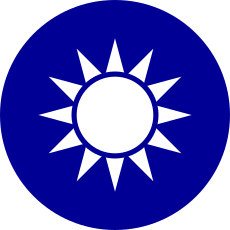Special municipality (Taiwan)
| Special Municipality 直轄市 Zhíxiáshì | |
|---|---|
.svg.png) | |
| Category | Unitary state |
| Location | Taiwan |
| Number | 6 |
| Populations | 1,884,284 (Tainan) – 3,966,818 (New Taipei) |
| Areas | 1,137.5545 square miles (2,946.253 km2) (Taoyuan) – 104.9425 square miles (271.800 km2) (Kaohsiung) |
| Government | Local government, Central Government |
| Subdivisions | District |
| This article is part of a series on |
| Administrative divisions of Taiwan |
|---|
| First-level |
|
| Second-level |
| Third-level |
| Fourth-level |
| Fifth-level |
|
|
Historical divisions of Republic of China (1912–49) Taiwan (1895–1945) |
Special municipalities (Chinese: 直轄市; pinyin: zhíxiáshì; Pe̍h-ōe-jī: Ti̍t-hat-chhī; literally: "direct-administered cities") are cities in Republic of China that have the rank of province. Along with Taiwan and Fujian provinces, the special municipalities are the highest level classification of administrative divisions in the Republic of China. Currently there are six special municipalities in Taiwan: Kaohsiung, New Taipei, Taichung, Tainan, Taipei and Taoyuan.[1]
Position in hierarchy
Special municipalities are the highest level cities in Taiwan. Some cities of lower levels may also refer to themselves as municipalities.[2] However, they are referenced using the following conventional terms:
Three levels of cities in Taiwan:
- Special municipalities (直轄市 zhíxiáshì)
- Provincial cities (市 shì or 省轄市 shěngxiáshì)
- County-controlled cities (縣轄市 xiànxiáshì)
History
Mainland Era
During Republic of China government rule in mainland China, twelve cities were elevated as special municipalities. They were:
| No | Name | Current place | No | Name | Current place | No | Name | Current place | |||||
|---|---|---|---|---|---|---|---|---|---|---|---|---|---|
| 51 | Nanking | 南京市 | Nanjing, Jiangsu | 55 | Tientsin | 天津市 | Municipality of Tianjin | 59 | Hankou | 漢口市 | Wuhan, Hubei | ||
| 52 | Shanghai | 上海市 | Municipality of Shanghai | 56 | Chungking | 重慶市 | Municipality of Chongqing | 60 | Canton | 廣州市 | Guangzhou, Guangdong | ||
| 53 | Peiping | 北平市 | Municipality of Beijing | 57 | Dairen | 大連市 | Dalian, Liaoning | 61 | Sian | 西安市 | Xi'an, Shaanxi | ||
| 54 | Tsingtao | 青島市 | Qingdao, Shandong | 58 | Harbin | 哈爾濱市 | Harbin, Heilongjiang | 62 | Mukden | 瀋陽市 | Shenyang, Liaoning | ||
The system of top-level municipality were designed in 1927 soon after they were designated as "cities" during the 1920s. These cities were first called special municipalities/cities (Chinese: 特別市; pinyin: tèbié shì), but were later renamed Yuan-controlled municipalities (院轄市; yuànxiá shì), by the Central Government. Seoul in South Korea still uses the term special municipality (特別市), pronounced teukbyeolsi (특별시).
Taiwan Era

Six special municipalities in Taiwan were created after the Republic of China government took control following World War II. Taipei was made a Yuan-controlled municipality in 1967; Kaohsiung was elevated in 1979; New Taipei, Taichung and Tainan also elevated to special municipality in 2010; and Taoyuan in 2014. Since 1994, Yuan-controlled municipalities (院轄市 yuànxiáshì) have been officially called special municipality (直轄市 zhíxiáshì, lit. direct-controlled municipalities) to emphasize their autonomy. Besides significant political, economic and cultural development, the ROC law dictates that a municipality must have population of over 1,250,000 people.[3] In terms of actual governance and not simply status, a special municipality has more authority to coordinate, push through, streamline, and plan as compared to the former administrative structure, because the change effectively eliminates a layer of intervening government, and not simply a layer but a powerful large city government is dissolved (with the exception of New Taipei as there was no such core city to dissolve), this particular type of conversion to a 2-layer system takes advantage of small government, elimination of redundant services and jurisdictions, and flat organization without changing the nature of the smallest units of local administration.
Administration
In Taiwanese municipalities, the mayor is the highest-ranking official in charge. The mayor is directly elected by the people registered in the municipality for a duration of four years.
Current special municipalities
|
Proposals for special municipalities[4]
| Changes | June 2009 Combined population |
Combined area (km²) | Map (before) | Map (after) | ||
|---|---|---|---|---|---|---|
| Taipei + New Taipei + Keelung → Taipei (臺北市 + 新北市 + 基隆市 → 臺北市) |
6,854,715 | 2,457.1244 |  |
 |
 |
.svg.png) |
